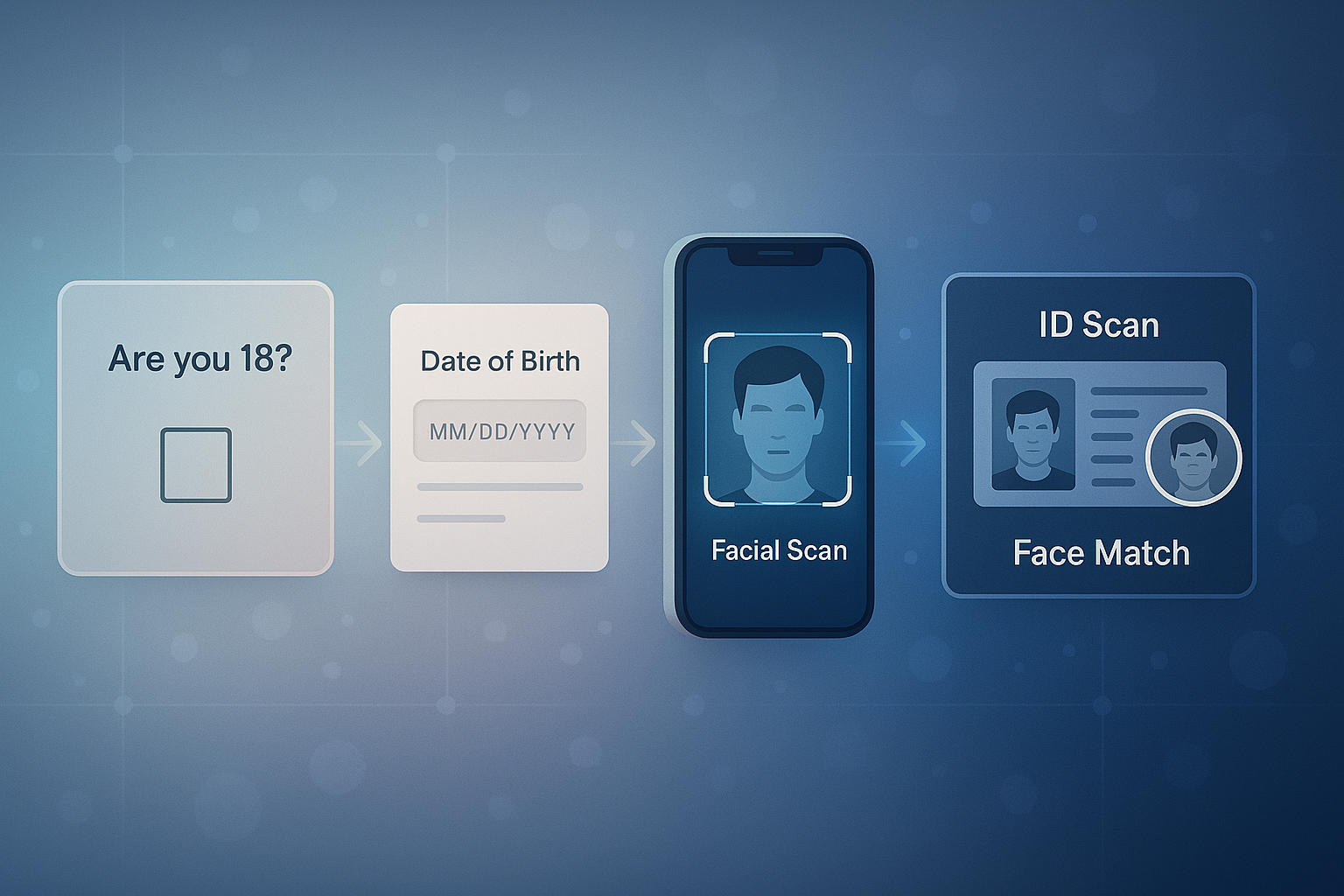
What Age Verification Regulators Really Want
November 6, 2025
Let’s face it: age gates were never an efficient tool in determining the age of a website’s user. But not only are they not effective, they are no longer legally valid in the UK, France, or Germany, and many other places, and that change comes with many consequences.
The Regulatory Shift
For years, websites across industries relied on the same self‑declaration mechanism: a modal asking “Are you over 18?”, a date‑of‑birth input, or a checkbox confirming age. These methods were easy to implement for the websites, but were equally easy for underage users to bypass, since all they had to do was click a button or two. Regulators tolerated them for a time, but that time has passed, with each one strictly outlining new requirements.
UK: Ofcom Defines “Highly Effective” Age Assurance
Under the Online Safety Act, Ofcom requires platforms to implement "highly effective" age assurance, with specific expectations published in its 2024 Draft Codes of Practice.
Ofcom makes it explicit that:
“Self-declaration of age (e.g., ticking a box) will not be sufficient to comply.”
— Ofcom, Children’s Safety Code of Practice, 2024
Acceptable methods must be demonstrably effective at preventing underage access. That includes:
- Facial age estimation (server-side, benchmarked against published thresholds)
- Government ID + biometric face match
- Auditability via logs or signed tokens
Ofcom has already benchmarked age estimation systems and accepts those that demonstrate a high detection rate for users under 16 and meet the overall threshold for accuracy, liveness, and privacy.
Platforms relying on user input, unverified redirects, or storage-based KYC flows are explicitly non-compliant.

France: Arcom Requires “Binding, Auditable, and Privacy-Preserving” AV
France’s SREN law, enforced by Arcom, defines five mandatory requirements for legal age verification:
- Binding — The age check must actively prevent access by minors
- Independence — The AV provider must be separate from the platform
- Auditability — The system must produce proof of enforcement
- No PII Leakage — No unnecessary exposure or storage of personal data
- Irreversibility — The decision must not be reversible or bypassable by the user
Arcom has already taken legal action to potentially block adult sites at the ISP level in case they refuse to comply with regulations. As such, checkboxes, age inputs, and even non-independent redirect flows have now all been deemed invalid.
Germany: KJM Requires Certified ID + Biometric Verification
Germany’s Kommission für Jugendmedienschutz (KJM) enforces the strictest age verification rules in Europe.
Requirements include:
- Liveness detection
- Government-issued ID scan
- Biometric face match between ID and live user
- No access prior to completion of verification
KJM permits two implementation models:
- Master Key (persistent identity system)
- One-Time Key (ephemeral session-based AV)
Both require certification and pre-approval. Systems that rely on estimation only, or allow access based on user-declared age, are categorically non-compliant under German law.

The Business Risk of Non‑Compliance
Checkboxes aren’t just ineffective — they’re a known liability. Platforms that continue to rely on self-declared age inputs now face:
- Regulatory enforcement, including takedown orders and ISP-level blocking
- Contractual risk, especially with EU-based partners and distributors
- Reputational damage, particularly around user data handling
- Legal liability, including fines and criminal exposure in high-risk jurisdictions
Most importantly, they fall short of the baseline due diligence now expected of any service operating in regulated European markets.
What a Compliant Age Verification System Looks Like
To meet current European regulatory standards, AV systems must:
- Use biometric age estimation with liveness detection (for low-friction flows)
- Support ID verification with face match (for high-assurance jurisdictions)
- Ensure ephemeral, in-memory processing — with no data retention
- Provide audit-ready logs and regulator-facing documentation
- Allow flow customization by geography and risk level
Any system that lacks these features, or relies on self-declaration is no longer defensible under European law.
SafePassage: Built for Regulatory Certainty
SafePassage is one of the only age verification platforms built specifically with the legal standards of Ofcom, Arcom, KJM, and other regulators in mind. No data storage, no PII risk, and no tradeoff between compliance and conversion.
Key differentiators:
- Zero self-declaration — only verifiable age assurance
- Zero retention — no images, IDs, or biometric templates stored
- Sub-minute verification — built for conversion, not friction
- Liveness and spoof detection — no way to trick the system
We’re not "regulator-friendly." We’re regulator-compliant, and built for legal peace of mind.
Don’t Wait for a Takedown Notice
Regulators have drawn a clear line, and they’ve already begun enforcement. Checkbox gates and self-attested age inputs aren’t just ineffective — they’re legally indefensible.
If your current system wouldn’t pass an audit, now is the time to modernize it with SafePassage (for free). If you’d like to read more on the changing regulatory needs of privacy-focused industries, follow us on X, Bluesky, and LinkedIn as well.
